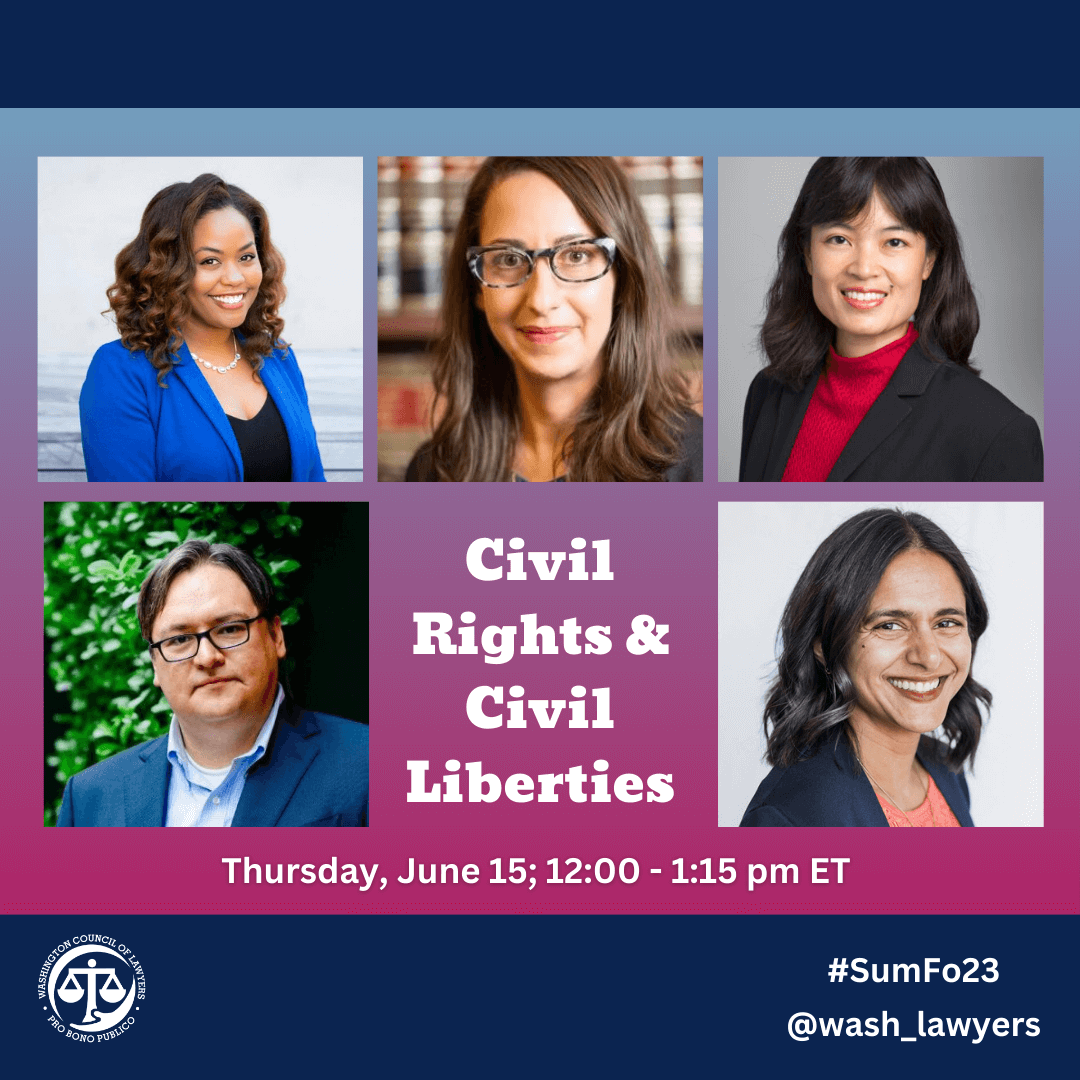
2023 Summer Forum: Protecting Our Rights and Liberties in the New Legal Landscape
The final day of the Summer Forum began with an eventful conversation from our Civil Rights and Civil Liberties Panel! They covered the breadth of their work, urgent and emerging issues in the field, and how to navigate some of the tricky situations arising from our legal system right now.
Our panel was moderated by Brandy Wagstaff, Attorney-Advisor in the Civil Rights Division of the Department of Justice. Our panelists include Erinn Martin, Director of Nominations & Cross-Cutting Policies at the National Women’s Law Center; Tara Ramchandani, Partner at Relman Colfax; Jim Ferg-Cadima, Former Deputy Legal Director at Lambda Legal; and Joanne Lin, Executive Director of the Washington Lawyers’ Committee for Civil Rights & Urban Affairs. Learn more about our panelists’ backgrounds and experiences here.
Understanding how to get involved in the civil rights field requires a look at where it’s been and where it’s going. Our panelists agreed that progress is not linear and stressed the importance of adaptability and preparation. From changes in the political landscape to the global pandemic, the needs of communities are constantly changing and with it the field of civil rights. That is why legal professionals must build a knowledge base and develop their skills by staying engaged with current affairs and getting involved in the work.
Our panelists weaved their examples of urgent and emerging issues with the always-present need for intersectionality and accessibility. One example arising from the pandemic was the redlining that cut communities of color off from lending practices due to the more lenient oversight. Looking recently at the Supreme Court decision that overturned Roe v. Wade, the civil rights field had to adapt to the overturning of a constitutional right for the first time . As a result, advocates are connecting the dots and seeing the interconnectedness of civil rights issues. To create an accessible system that addresses the harms that were brought to light by the pandemic and recent political changes, advocates are calling for democracy reform at the state and federal levels.
When looking ahead to what is coming and how to prepare, our panelists recommend looking back at methods from the 1990s. Given the current Supreme Court, it may not be wise to push high-impact litigation to the top for a while, so the question becomes what else is there to do? Speaking specifically to the attack on trans individuals, there are considerations at the institutional and individual levels. At an institutional level, there is a growing legislative trend of anti-trans laws and queer rights institutions need to have hard conversations with clients that cannot take their cases to the Supreme Court. At the individual level, we need to adopt past methods of advocacy that focus on transactional work to maintain family protections like contracts, wills, and other family law protections. The goal now is to pay deep attention to strategies to protect individuals.
The pandemic also impacted advocacy for disability rights by highlighting the lack of support for individuals with disabilities and increasing the number of people with disabilities. Our panelists discussed how as a society we need to prioritize supporting individuals with both visible and invisible disabilities. For example, paid medical and family leave allows folks to take the time off they need to care for themselves and their families. There’s also a need to envision incorporating universal design into more of our spaces, physically and virtually. While the pandemic put a spotlight on these issues, they have been ongoing and growing, it is imperative to listen to the disabled community and make changes that improve accessibility for all.
A question from the audience sparked a conversation on reparations and restorative justice asking whether reparations were possible. The simple answer is yes; reparations law is an emerging field with a lot of questions to be resolved, but the conversation is happening in a way it has not been allowed to progress before. Additionally, restorative justice is becoming a normative way of handling disputes. School systems are using restorative justice rather than punitive measures and the students coming from those schools see it as a normal part of advocacy and conflict resolution. This is creating a way for people who have been hurt to be heard and allows the person that caused the harm to be involved in the solution.
When looking for how to get involved in the work, our panelists had creative advice. When graduating from law school, look for fellowships at organizations that focus on getting folks into civil rights work and follow that path into public interest. If you choose to go the firm route, volunteer where you can through pro bono service. As a student, there are creative ways to make an impact such as a split summer, spending time at a firm, and the time off working at a legal service organization. Student organizations also have greater access to research resources and time they can donate to do research for organizations in litigation or advocating for complex issues. You can also be a member of organizations working to support communities focused on your interest area, your membership fee helps to support them in doing their vital work.
Finally, the panel concluded by advising advocates to broaden the places they go to do good. In Washington, D.C. we can be caught up in federal and national level issues. There may be a greater opportunity to impact the people experiencing these issues by advocating at a state or local level. Advocates are also needed in rural communities where few people are addressing the immediate needs of the area.






